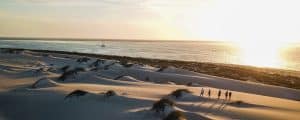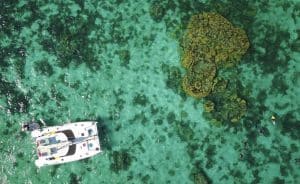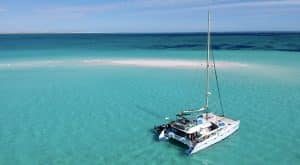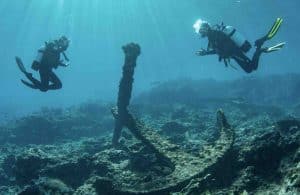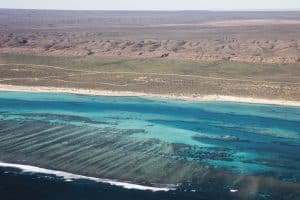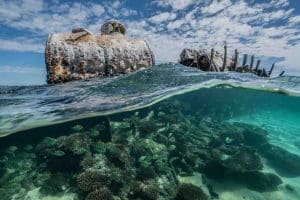Ningaloo Reef in Western Australia has long empty beaches, astonishing marine life and world-heritage listing combined with a strong cultural heritage. It tops many a wishlist of discerning travellers for the opportunity to experience iconic marine wildlife interactions.
Here are 11 little-known facts about Ningaloo Reef that will bump it up to the top of your wishlist!
1 – Ningaloo Reef is a treasure trove of maritime history, dotted with shipwrecks that you can explore both scuba diving and snorkelling
Long before Ningaloo Reef was famous for the opportunity to swim with the largest fish in the sea and snorkel with Whale Sharks, it was famous to ocean mariners for a very different reason – it’s treacherous nature to passing ships.
Shipwrecks are found all along the West Australian coastline! For more information about wrecks of Ningaloo Reef and the Coral Coast download this great d
ocument from the Museum of Western Australia.
When conditions allow you may have the chance to snorkel or dive one during a Sail Ningaloo 5 night Ningaloo Escape tour.
2 – 69 Species in the IUCN Red-list of Threatened Species find protection in the Ningaloo Reef Marine Park
The marine life statistics for Ningaloo Reef are quite amazing:
- More than 50 per cent of Indian Ocean coral species are found at Ningaloo Reef, with over 300 species in 54 genera
- The marine park also contains 738 species of reef fish, over 1,000 species of marine algae, 600 species of crustaceans, 655 mollusc species and 75 species of true cave invertebrates
- The slope and shelf communities of the world-heritage area are exceptional with 155 sponge species, most new to science and at least 25 new species of echinoderms (that is just the known ones!).
- Plus 69 Species from the IUCN red-list of Threatened Species
3 – Ningaloo Reef is one of the largest biological structures visible from space
Often compared to it’s east coast cousin (Great Barrier Reef), Ningaloo Reef in Western Australia is very different. It is a fringing reef, visible from space and one of the largest biological structures known.
“From gorges such as Shothole Canyon, the visitor looks across ancient limestone cliffs, built from sediments deposited in vanished oceans, to the living reef below; and the finer resolution afforded to a diver reveals the spectacular coral gardens, rich colours and abundant life of the reef”. Source: Ningaloo Coast World Heritage Nomination.
4 – The Ningaloo Coast and Reef get their name from Australian Aboriginal Wajarri language
The Nyinggulu (Ningaloo) Coast is culturally significant to Aboriginal people, who have an ongoing connection to the area spanning between 30,000 to 60,000 years before present. The word “Nyinggulu” was recorded in the 1800’s and means deepwater. Other suggested meanings include promontory.
Materials found in rock shelters, shell middens and caves on the Cape Range peninsula indicate that Aboriginal people lived on the Ningaloo coast for over 30 000 years. Some archaeologists suggesting this may in fact be closer to 60,000 years. These sites provide the earliest evidence for human decorative ornaments in Australia.
5 – American whalers operated in the area some 90 years before European settlement
The first recorded contact with North West Cape was in 1618 by the Dutch ship Zeewolf. Later, American whalers were known to frequent the area conducting ship-based whaling (the whales were ‘processed’ onboard). Shore-based whalers operated from the historic Norwegian Bay from 1913. Between 1936 and 1938 factory ships with chasers operated off the north-west coast, taking a total of 7,240 humpback whales in three years. Source: Ningaloo Reef Marine Park Management Plan
Thankfully, whaling was ceased before whale populations were completely decimated. These days the annual humpback whale migration to Ningaloo Reef is a celebration and a joy. Whales put on spectacular displays, including breaching where they are able to launch their whole body out of the water!
You can now swim with Humpback Whales on Ningaloo Reef between July – October.
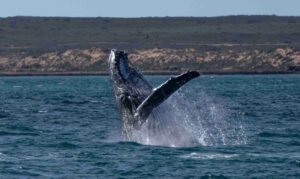
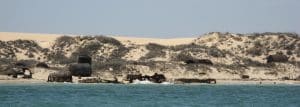
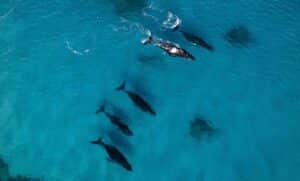
6 –At Ningaloo Reef in autumn each year there is a mass spawning of Corals
In March and April each year, the coral spawns 7-10 days after the full moon, releasing billions of tiny eggs and sperm into the water column. Coral spawning occurs during the middle of the night therefore it is rarely witnessed. The effects are hard to miss though as the spawning is a major source of food for many marine animals.
The Leeuwin Current is a great flow of tropical water that moves southward along the Western Australia coast. The current takes coral eggs and fish larvae that don’t settle on the Ningaloo Reef south with it. These may settle as far away as the Abrolhos Islands or Rottnest Island! The Leeuwin current begins to strengthen at the same time as the coral spawning, having a major influence over Western Australia marine life.
7– Coral Bay Beach voted as one of Australia’s Top beaches!
Given that Coral Bay is off the beaten track for the vast majority of travellers to Australia, it is pretty impressive to see Coral Bay Beach rank so well! Perhaps it is the fact that you can snorkel amongst coral gardens straight from the beach? Or the incredible sunsets over the Indian Ocean? Maybe it is the lack of crowds or the long beautiful stretch of sand. Perhaps it’s the joy of paddling a kayak out across the coral? Perhaps it is all of these!
8 – The Ningaloo Coast has an estimated 10,000 Turtle Nests Each Year!!
Three of the world’s seven marine turtle species nest on the beaches of Ningaloo Reef each year. Turtles nest during the summer months (Nov – Mar), including Loggerhead Turtles, Green Turtles and Hawksbill Turtles. You can snorkel with turtles on Ningaloo Reef year round.
The Cape Conservation Group, DBCA and Murdoch University have developed the Ningaloo Turtle Program which has been running for over 22 years! The program contributes to the conservation of marine turtles and their associated habitats. Learn more about the Ningaloo Turtle program and how you can join their volunteer efforts.
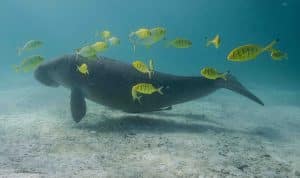
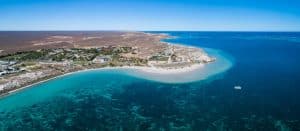
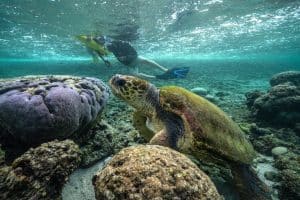
9 – Ningaloo Reef is a mega-fauna highway!
“Large mammals abound in this marine Serengeti. At least five species of giant baleen whales regularly visit the park. This includes the three largest of the rorquals (blue, fin and sei whales), humpback whales, and northern minke whales. Dolphins, orcas and sea lions play and hunt in waters off the reef. A dugong community of up to 1,000 animals feeds in the seagrass beds”. Source: Ningaloo Reef Marine Park Management Plan
Visitors to the Ningaloo Reef Marine Park can snorkel with manta-rays, turtles, whale sharks, whales, reef sharks and more. Spot dolphins whilst sailing Ningaloo Reef. See dugongs close to sea grass beds, where they graze for food. Find out more about Ningaloo Reef wildlife.
10 – The Ningaloo Coast has Subterranean Habitat and Fauna that were important in it’s World Heritage Listing
The Ningaloo Coast karst habitat and associated anchialine ecosystems show that a subterranean system can function similarly to an ocean island or archipelago in terms of preserving biodiversity. The biogeographical associations of the underground fauna of the Ningaloo Coast reveal climate changes over thousands of millennia on a local and regional scale. They also chronicle the geotectonic meandering of Australia across hemispheres and tens of millions of years which contributes to the reconstruction of supercontinents and vanished oceans. Source: Ningaloo Reef Marine Park Management Plan
Cape Range National Park is the terrestrial national park that lies adjacent to Ningaloo Reef. It is one of the most beautiful coastlines in Australia and well deserving of its World Heritage status.
11 – Sail Ningaloo is the only dedicated Ningaloo Reef live-aboard tour operator!
Sleep on the reef in comfort and luxury! Our multi-day, overnight sailing holidays allow you to fully immerse yourself in the Ningaloo experience. Enjoy incredible snorkelling and scuba diving, with time to relax and unwind. Come and experience Western Australia’s very own Ningaloo Reef in comfort & style on board Shore Thing with Sail Ningaloo!
